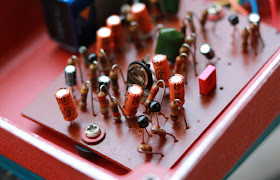
What is a capacitor?
A capacitor is a passive component made of two plates separated by air or a good insulating material called "insulator". Hence its symbol you will find in schematics: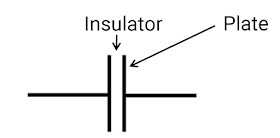

Capacitor can store a charge, much like a mini battery!
Capacitors have two main characteristics:
- ⚡️Capacitance: the amount of charge they can stock.
- ⚠️ Voltage rating: the maximum voltage they can handle.
They are the two main features you will have to look for when buying or inspecting a capacitor.
The capacitance is expressed in Farads. however, most capacitors we are going to use in guitar pedal making have very low farad capacitance. Most of the capacitors we are going to use are microFarad (µF), nanoFarad (nF) or picoFarad (pF).
1 µF = 1,000 nF = 1,000,000 pF
Usually, when building guitar pedals, we use all sorts of values. However, a voltage rating of 25V is usually more than enough because voltage in guitar pedals is most of the times limited to 9V or 18V. If you use a bigger value, no problem! Just pay attention to the size of capacitors (more about that later).
These values are printed on the capacitor. For instance on this Wima capacitor, the value is printers (0.33 µF) as well as the voltage rating (250V) :
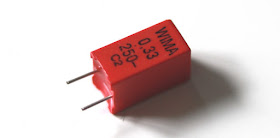
When you apply a voltage to a capacitor, it will store an amount of charge and can restore it later when discharging. Kind of a mini battery. Capacitors also let AC current go through them, but not DC.
When you combine capacitors, capacitors in parallel will have a combined capacitance equal to the sum of both capacitances. In parallel, capacitance will usually be lower, but voltage rating increases.
Here a schematic:

What does a capacitor looks like?
Capacitors can have many different aspects. But most of the times, they have two legsYou can have a read on my blog post: capacitors: which one to choose?
The most common capacitors you will find in guitar pedals are electrolytic capacitors, film capacitors and ceramic capacitors. They are easy to spot on a circuit. 🔎
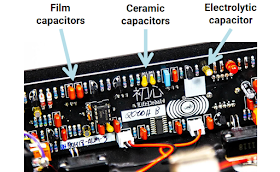
Beware of the size of capacitors! Some can be really huge and will never fit a guitar pedal...
Generally speaking, the bigger the voltage rating and capacitance, the bigger the capacitor. This is especially true for electrolytic capacitors, which can have prodigious size (with no intrinsic merit.. )
Generally speaking, the bigger the voltage rating and capacitance, the bigger the capacitor. This is especially true for electrolytic capacitors, which can have prodigious size (with no intrinsic merit.. )
For instance, these two capacitors are the same voltage rating (25V), but their value is different (100 µF vs 1000 µF):

Now imagine a 1000 µF with a 250V voltage rating! When ordering capacitors, always look to their dimension to avoid any bad surprise.
Roles of capacitors in guitar pedals
Capacitors are used for three purposes in 99.999% of guitar pedals: as power supply filter capacitors, as coupling capacitor and in RC filters circuits.Power supply filter capacitor
A classic role of capacitors is to smooth out the remaining ripples in your DC power supply. Indeed, the voltage in your power outlet is AC and pedals need DC current.However the remaining current can still have a lot of ripples in it. Here is a schematic of what happen in a power supply:

The AC voltage from your power outlet is transformed into 9V AC by a power transformer.
Then a diode bridge made of 4 diodes or a rectifier tubes (for amplifiers) revert the negative voltage waves to have only a positive voltage remaining.
But this is not DC current, there are still a lot of oscillations going on here. This is when filter capacitors come into play!
Big capacitors (usually electrolytics) are used to store a voltage and release it when the power supply goes down. Thus it generates a DC voltage!
However, most of the times, there are still some ripples remaining in the DC provided by your pedalboard power supply, which can generate noise:
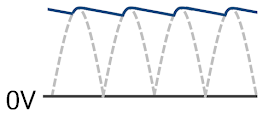
Here is an example from the Vemuram Jan Ray pedal:

You will very often find them in guitar pedals and I recommend incorporating them as well. They usually are electrolytics with big value like 100µF for instance. I also recommend to add a smaller value 0.1µF capacitor (for complex reasons linked to Equivalent Series Resistances...etc. Trust me, it is worth it!).
Coupling capacitors
A characteristic of the capacitor is that they let AC signal go through them but not DC.Because of that property, they are often use to prevent DC current to mix with your guitar signal (which could generate noise!). Read my blog post about guitar signal to know more.
You will see very often capacitor placed after a stage with DC voltage. For instance in this Big Muff schematic:
As you can see, there are lots of them!
They are usually film capacitors of medium value (between 1nF-0.1µF).
They can influence the amount of bass going through the circuit. The bigger the coupling caps, the more bass you will have. , That is why in bassy circuits like the Univox Super Fuzz, you can see coupling caps up to 10 µF!
RC filters : adjust those bass and trebles
In combination with a resistor, a capacitor can form what is called a "RC filter". It will basically filter frequencies above or below a certain threshold called "cutoff frequency".
A high pass filter lets trebles go through, and a low pass filter let the bass frequencies go through. As you can see, the sound is not "cut" directly, but is reduced progressively. The cutoff frequency is calculated that way:

(R is in Ohms, and C in Farads)
So depending on the value of the resistor and capacitor, you will filter more or less trebles / bass. Use a potentiometer instead of a resistor and you've got a tone control! A famous example using two RC filters is the Big Muff tonestack. Read more about it here.
An example
Here is a simple circuit the use capacitors the same ways described above:This is the famous buffer used in the Klon Centaur pedal. As you can see there are four capacitors: one 0.1 µF capacitor and three polarised electrolytic capacitors (2x 47 µF and 1x 4.7 µF).
The signal goes through the 0.1 µF and 4.7 µF capacitors. They are used as coupling capacitors to prevent parasitic DC current to go in and out the circuit.
The two 47 µF capacitors are used as filter capacitors for the power supply to ensure a good DC supply and avoid noise.
Here is a schematic:
There you go! Here are most roles of capacitors in guitar pedals. After reading lots of schematic, you will always know why a capacitor is there or there 😀
I hope this post was useful to you. Join the Coda Effects community by liking the Coda Effects Facebook page. You can also follow Coda Effects on Instagram.



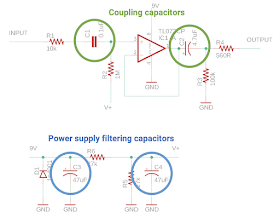
Great! As always! Thank you!
ReplyDeleteWhere can I buy a 1mm 10v 220 microfarad capacitor replacement for my boss pedal? Thanks.
ReplyDeletePretty much answered all my questions regarding capacitors in effects pedals, especially the use of coupling capacitors. Awesome article, very informative.
ReplyDeleteGood day, i am doing research right now and your blog really helped me, https://royalcbd.com/faq/
ReplyDeleteWhen you say:
ReplyDelete"When you combine capacitors, capacitors in parallel will have a combined capacitance equal to the sum of both capacitances. In parallel, capacitance will usually be lower, but voltage rating increases."
Maybe you want to say "In series, capacitance will usually be lower"??